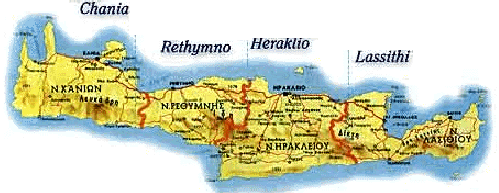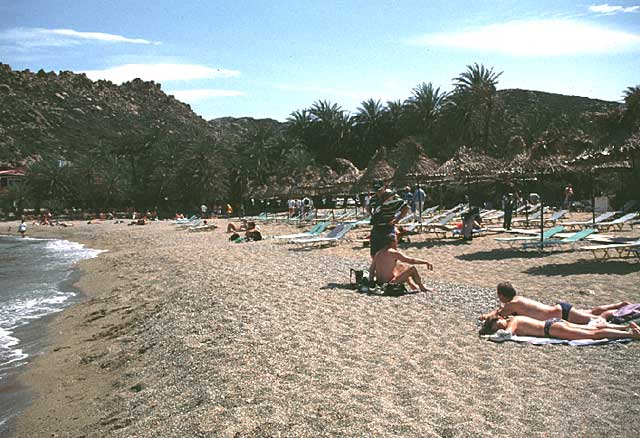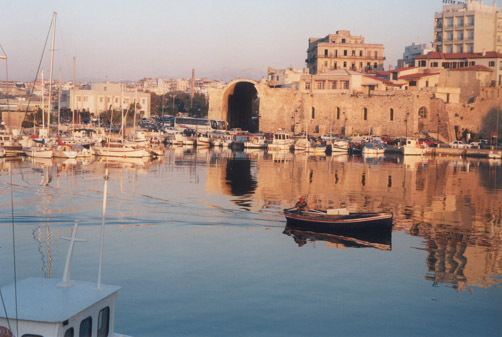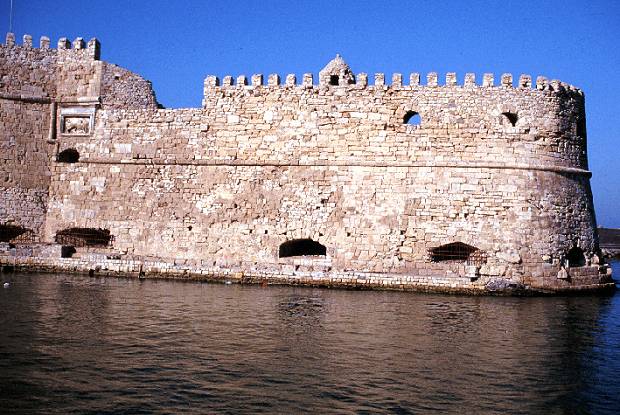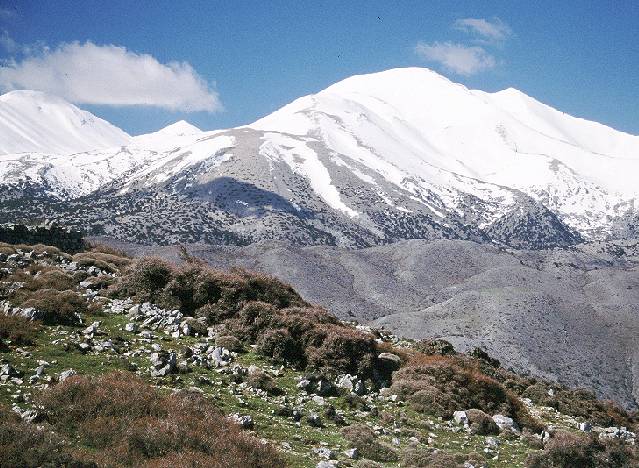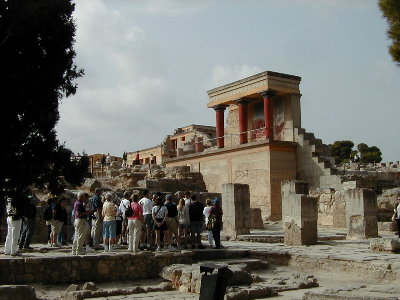1. GENERAL INFORMATION’S
EXPANSE AND POPULATION: Crete is the largest of the Greek islands
and largest in the Mediterranean sea after Sicily,
Sardinia and Cyprus.
It is located in southeast of the Mediterranean sea and it is also the most
southern point of Europe. It lies at the
Southern Aegean Sea and at the crossroads of three continents Europe, Asia
and Africa.
The island Crete is one of 13 large territories of Greece and
her total population is
601.131 habitants. Capital cof Crete
is the city of Heracleio.
All the large cities of the island are situated on its northern side and all
border with the sea. From west to east, these cities are as follows: Chania, population 53.373, Rethymno,
31.687 , Heracleio,
137.711, Aghios Nikolaos,
19.462.
Crete
covers an area of 8.336 sq. kms. The length of the
island is 260 km,
but the shore-length is 1.046
km. The biggest width is 60 km from the Dion cape to the Lithinon cape,
while the smallest is 12 km
and is called "isthmus of Ierapetra".
CLIMATE: The climate of Crete is
considered as one from the more beautiful, healthier and more softly of Europe. A factor, which plays decisive role in the configuration
of climate, is the sea that surrounds the island. In the coastal regions,
particularly in the southerner coastal regions, the climate it is so much
mild so that here are cultivated tropical plants, for instance bananas. The
city of Jera'petra
is considered the hottest Greek city and her region is considered as the hottest
lands of Greece.
MOUNTAIN RANGES: Crete is island
especially mountainous. A high mountain range crosses the island from West to
East, formed by three different groups of mountains. There are three big mountain
ranges with their ramifications where they unfold as backbone at length of
island. In western Crete is found the mountain chain of the <<White Mountains>> (= in Greek: ËåõêÜ üñç,
pronunciation <<Lefka ori>>)
and cover the bigger department of the prefecture Chania,
with taller top the Rimes, in the 2.456 altitude. In the centre of island is
found the mountain chain of the <<Tall mountain>> ( pronunciation “idhi or Psiloritis”), with taller top the Idi,
in the 2.456 m.
In the eastern part of Crete is found the mountain chain of the <<Mountain of Jupiter>> (= in Greek: Äßêôç, pronunciation “Dhikti”, from “Äßáò
> Äßêôç, ôßêôù - äßêôù”, according to ancient
writers.) , with taller top the “Spathi”
in the 2.148 metres
in height.
GORGES – RIVERS – LAKES: The most famous gorge of Crete is that of Samaria’s in the western part of Crete, in the White Mountains. It is wild, unapproachable and has 18 kilometres
length, width 3-40
metres and depth 600 metres. In the
plateau of Omalos, from where it becomes the access
to this, exists big cavern gulf with internal lakes.
It follow the gorge of Nimpru, in the eastern side
of the White Mountains and the Kurtalio'tiko gorge
in the prefecture Rethymno, that leads to the monastery
(abbey) of Preve'lis. The biggest rivers are the Anapoda'ris and the Geropo'tamos
in the plain of Messara's. Others rivers are Kakope'ratos and Kole'nis, that
are poured in the gulf of Kjsa'mu, the Tayroni'tis, the Keri'tis or Platanja's, the Cerisiano's and
the Kladjso's that is poured in the gulf of Chania and others. Three from the rivers of Crete have salty waters, “Almiros”
of Apokoro'na, length 1hlm.,
“Almiros” of the Heraklion,
length 2hlm. and “Almiros”
of the Mirampe'llu, near in the coasts.
In Crete there are three small lakes. His
bigger Kurna' is found in the Apoko'rona,
the other in in the city of Saint Nikolaos
and third in the province Kjsa'mu.
BEACHES: In the prefecture of Chania there are two
splendid beaches, the Elafoni'sj in the southwestern and the Falasarna
in the northwestern, while one of the bigger
beaches is found in the Georgia
town (Georgiupoli), between Chania
and Rethimno. A tropical beach, that is found in
east part of Crete is the beach Va'j, a paradise
landscape, where there is the alone natural palm of Europe (Here is the
unique forest of palm tree of the Europe). The
beach of Ma'tala , in southerly the Heraklion,
is known for his caves while it allocate also a enjoyable sunny beach with
sand. There are, also, beautiful beaches in the Frankokastelo,
Long Seashore , Down Za'kro
, Pre'veli , Palajo'hora
, Saint Pelagia , J'stro
and Ma'lja .
2. COUNTIES, PREFECTURES, CITIES etc
The island Crete is divided into four Prefectures (which are subdivided
in provinces), which from west to east are: the Prefecture of Hania, with Hania as the
capital, the Prefecture of Rethymnon, with Rethymnon as the capital, the Prefecture of Heraklion, with Heraklion as
the capital, and the Prefecture of Lassithi, with Agios Nikolaos as the capital.
Crete
is divided into four prefectures, those of Chania, Rethymnon, Herakleion and Lasithi:
Prefectures of Chania = 150.387 habitants,
with 23 municipals and 2 small Communities, capital city is the city of Chania
with 53.373 habitants.
Prefectures of Rethymno = 81.936 habitants, with 11 municipals and
capital city is the city of Rethymno with 31.687 habitants.
Prefectures of Heracleion = 292.489 habitants, with 26 municipals and
capital city is the city of Heracleio
with 137.711 habitants.
Prefectures of Lassithi = 76.319 habitants, with 8 municipals and
capital city is the city of Aghios Nikolaos
with 19.462 habitants.
All the big cities of Crete are found
in the northern side of island and are wetted by sea. From west to East is
the cities: Chania, Rethimno
Heraklion, Agjos Nikolaos, Sitia etc In the
South the bigger towns are: Hierapetra, Tympaki, Moires.
Ancient famous towns: Knossos, Paistos, Gortyna, Lyctus or Lyttos, Kydonia etc
COUNTY LASSITHI: The prefecture Lassithi covers the Eastern
utmost of the island. The prefecture is separated in the four provinces: Mirampe'llu, Lassithi, Jera'petras and Sitia. The
largest cities are: Agjos Nikolaos,
the Jera'petra and the Sitia.
According to the fable and the ancient writers, the Djktaj'o
antro in the Plateau of Lasithi it was the place of birth and his
upbringing of the Jupiter.
Certain of the ancient cities of Crete
were discovered in the prefecture Lassithi. In them
they are included: Bassiliki, My'rtos,
Palace of Za'kros , Prajso's, Mohlos,
Goyrnja' . A important
ancient Greek city, the Lato, finds itself near in
the Kritsa'. In the marvellous archaeological
museums of Saint Nikolaos and Sitia
are exposed somebody of the discoveries of these excavations.
The region round the Saint Nicolas (= in Greek: Aãéïò
Íéêüëáïò,
ðñïíèíøéáôéïí
«Aghjos Nikolaos”) is not
only the most developed tourist region but also one from the most interesting
things.
The church of Virgin Mary Kera's near in the Krjtsa' has
certain from the Byzantine frescos of the Crete.
There is A Venetian castle in the Eloy'nta . The region of Sitia is full
from Byzantine churches, Venetian villas and ancient regions of Minoans. The
Monastery of Toploy' allocates a museum where is
exposed the collection of his pictures. The excluded monastery of Kapsa offers in the visitor a picture of monastic life. Interest
have and the Sitia. There are Minoan installations
in: Mohlos, Palai'kastro, Minoan' Palace of Za'kru
etc Interest they present the Gorge of Deaths in the Za'kro
and the Hellenistic region of Jta'nu that is found
near in the Va'j. There are enough Byzantine
churches in the region and traces of Venetians in the Etia'
and in the Chantra .
COUNTY CHANIA: The prefecture Chania covers the western
department of island and has expanse 2.376 square kilometres. It is
subdivided in five provinces: Celery, Kydonj'as, Kjsa'mu, Apokoro'nas and Sfakia. The largest cities of prefecture are Chania, the capital of prefecture: Kasteli
in the Kj'samo, Palaiochora
and Ka'ntanos in the Celery, the Country Sfakj'wn in the Sfakia etc
COUNTY RETHYMNO: The Rethymno is the smaller prefecture of the Crete) and is found between the prefecture Heraklion and the prefecture Chania
and is subdivided in four provinces: Rethimno, Mylopota'mo, Amari and Saint
Kingdom. The most important cities of region are the Rethimno,
Anoghia, Amari etc
COUNTY HERAKLION: The prefecture
Heraklion is the bigger of the Crete, has the
bigger population, while it is also the richer region of Crete.
It has the biggest at head income. The prefecture Heraklion
is subdivided in 7 provinces: Malevjzj', Teme'no and Plain are found in northern beach and the
provinces Pyrgjo'tjssas, New, Monofatsi
and Via'nnu are found in the centre and in the southern
beach. The largest cities of region are the Heraklion,
Ma'tala
, Tympa'kj , Fates , and Ano Vja'nnos .
The prefecture Heraklion is found between two
mountain ranges, the J'di in western and the Dj'kti in Eastern. The valleys behind the city of Heraklion
produce many from the more beautiful grapes, eatable or for the production of
raisin. In these valleys the English archaeologist. Evans discovered the
Minoan Palace of Knososs’, the ruin ruined
buildings of big culture.
There are found important archaeological regions (of Minoans, of
ancient Greeks and Romans): Phajsto's , Saint Trinity, Go'rtyna etc.
The prefecture Heraklion has enough sights. There
are ruined buildings of bigger cultures, the most beautiful collection of
Minoan discoveries and the Byzantine churches that are scattered everywhere. There
are still Venetian castles and sjntrjva'nja. The
villages and the monasteries have they demonstrate a history of fights for
the independence that appears from the monuments for those that died fighting
against the conquerors of Crete.
The beaches in the Saint Pelagia and the
Peninsula in the northern, the Ma'tala and the Good Ports
in the southerners, attract the visitors with their hot and clean waters. Marvellous
restaurants and taverns in all the prefecture offer spesjaljte' the Cretan cooker.
The Eastern department of prefecture Heraklion
has the bigger coastal tourist resorts. The Limin Chersonissu and the Mallia are
certain from bigger archaeological sights, with ancient buildings and enough
important Byzantine churches.
3. HISTORY & ARCHAEOLOGY
Crete
is a place with a great history from ancient times. Crete
offers visitors a priceless wealth of findings of all the civilizations that
flourished on the island in its museums and in its archaeological sites. The
island is full of relics of the Minoan ages the most famous being the palaces
at Knossos
and Phaistos.
Crete
is famous for its high distinctions in the area of arts and letters. Three of
the most known figures in these areas are the painter Dominikos
Theotokopoulos (El Greco), the author Nikos Kazantzakis and the great
Eleftherios Venizelos
(Politician and prime minister of Greece)
No one is certain as to when Crete was
first inhabited. Its history is lost into the depths of the centuries. The
first traces of human presence on Crete
appear to be during the Neolithic Age, that is, around 6000 B.C.
A description of it in the writing system of today can be found in
Homer and Hesiod (Theogony)
and in the previous system (Linear Writing A and B) on the epigraphs of Knossos and Phaestos and others
The first known historical period of Crete, the Minoan period, begins
in 1453 before Christ (time of king Minoas), during which Crete experienced its most flourishing
period as a great merchant marine power. It was during this period that the
palaces of Knossos
were built. During this same period, the Minoan ships travelled and engaged
in trade with all the peoples and states in the Mediterranean.
The cultural influence that resulted from trading with all these peoples and
states is what formed the Minoan Civilization. The Minoan Civilization is the
distant ancestor of what we call European Civilization today, its centre
being Knossos.
Crete was under Roman Occupation from 69 B.C. to 330 A.D. Saint
Paul, who undertook the task of organizing the Church of Crete,
visited the island in the year 62-63 B.C.
During the first Byzantine period, Crete
was briefly occupied by the Arabs, between 824 and 961. In 961 and during
the years of Romanos Melodos
II, Crete was under the rule of Nikoforos Fokas
The Second period of the Byzantine Empire
spans between 961 A.D.
and 1204 A.D.
A major strengthening for the island was the appointment of twelve young
noble men by the Byzantine Emperor. These noble youths were granted vast areas
of land by the Emperor Alexios Komninos.
The islands Administrator of the time bears the title of Duke.
From 1211 A.D.
to 1669 A.D.
Crete is under Venetian Occupation. There
follow a number of revolutions against this occupation, all of them, however,
unsuccessful. The most enduring of these revolutions started in 1282, lasted
17 years and was led by Alexios Kallergis.
During the Venetian period, Crete flourished
in the area of arts and letters. Among others, two major poets of the period
were Vincenzos Kornaros,
whose masterpieces include Erotokritos and The
Sacrifice of Abraham, and Georgios Hortatzis, author of the famous Erofili.
There follows the Turkish Occupation (1669-1898 A.D.), during which Crete falls into absolute spiritual and intellectual
darkness. With the Greek Revolution of Independence in 1821, Crete failed to gain its freedom. It remained under
Turkish rule and, for a period, autonomous before its union with the rest of
the nation. During this period, the Christian spirit was intensified and
contributed considerably to the Resistance of the Cretans, who suffered many
sacrifices and bloodshed against Ottoman rule
Following many a battle and loss of lives, the great powers
collaborated in appointing Prince
George as High Commissioner of Crete in 1898. The
Cretans, however, did not approve of his authoritarian regime and rebelled
against him the famous Therisso Revolution of 1905.
This is the moment that the star of the great Eleftherios
Venizelos is born.
On December 1, 1913, Crete is
announced unified with the motherland. In 1941 the Germans come to occupy the
island, using parachute forces.
The Cretans with his partners (Britain’s,
Australians and from New
Zealand soldiers) responded with heroic resistance
but were finally defeated. Yet, this was proven a Pyrrhic victory for the Germans.
Today, Crete is peacefully developing
and prospering
KNOSSOS,
THE FIRST CAPITAL OF CRETE
& MINOAN CIVILIZATION
Knossos is the first capital city of Crete and where was the palace of
king Minos and his ascendants (Lycastus,
Idomeneas etc), according to ancient writers Homer,
Thucydides, Plato, Strabo etc.
The archaeological site of Knossos is at
a distance of 5 km
southeast of Herakleio, near the small village of
the same name, on a hill and it is the most famous archaeological site on Crete. A local bus (No2) runs very regularly between Heraclion and Knossos.
The town Heracleio is built on the site of
the small harbour which was the seaport of Knossos.
This small harbour much later became an important fortified town under
the Arabs, who held it for a period of over one hundred years (824-961 AD). Thy
build strong walls to protect it and surrounded it with a deep moat (from
which it got its name "Chandax" from the
Arabic word 'Khandak' meaning moat.
Knossos contains the ruins of the largest and most luxurious Minoan palace,
built in the middle of a large town. The impressive Minoan palace of Knossos is
famous throughout the world for its association with the myths of the
Minotaur, the Labyrinth, Daedalus, Ikarus and of course of Theseus, and the most ancient civilisation in Europe. The palace overlooks a small valley through
which a stream (called the Kairatos) runs for most
of the year. The palace contains roughly one-half-million square feet of
floor area, distributed over three to five floors (due to the sloping site),
not counting basement storage rooms. It is home to perhaps a thousand people.
It has courtyards, reception rooms, apartments for the king and queen, workshops,
storerooms, shrines, a whole wing of private apartments. It is a
self-contained city in itself.
The first palace
of Knossos was built
from King Minoas and with help of famous Athenian
architect Daidalus in 1453 b.C.,
according Plutarch, Siceliotis. Pario
Chronicle etc
MINO(A)S & MINOAN CIVILIZATION
The best-known period of Crete is the
period of the Minoan Civilization. During that period, 1400 – 1200 b.c., Cretans put out from Aegean see (and from islands Cyclades ) the
barbarians (= the Carians and Phoenicians) and so
the Greeks stopped the emigration,
made cities, made civilisation,
house etc, according to Thucydides, Isocrates etc.
The king Mino(a)s was the first from Greeks who made
army navy and wise written legislations
in ancient world, according to
ancient writers Herodotus, Thucydides, Plato, Strabo
etc
The king Minoas was King of Crete three
generation before Trojan war (first king of Crete was Minoas,
after Lycastus and after Idomeneas,
who was king of Cretans in Trojan war), according to Homer, Herodotus, Thucydides etc or exactly in
1210 before Diochnitus or in 1453 before Christ,
according to Pario Chronicle.
Telephones:
|
Tourist Police: 2810- 283
190
Traffic Police: 2810- 282
031
Hellenic Organization of
Tourism: 2810-228 225
Archaeological Museum of Iraklion:
2810-226 092
Archaeological Site of Knossos: 2810- 231
940
Archaeological Site of Festos: 28920-42315
History Museum of Crete:
2810-283 219
Archaeological museum of Agios Nikolaos:
28940-24943
|
Airport of Iraklion: 2810- 228 402
Olympic Airways: 2810-
229-191,244-802
Port Authorities: 2810-
244 912
Bus Station to Rethymno and Hania: 2810-221
765, to Hersonissos, Malia,
Stalida, Agios Nikolaos, Siteia: 2810- 245
017(-9)
To Messara
(Tympaki, Agia Galini, Moires, Lentas, Kaloi Limenes, Festos): 2810-255
965
|


